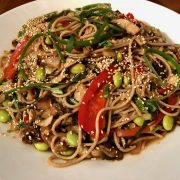Nutrient-Density for Life
I get asked all the time about my workout routine and I’ve explained more times than I can remember that it’s not just about being active—even walking half an hour a day matters, but that’s a different conversation. Fundamental to my physical fitness is my eating lifestyle.
And it all boils down to choosing nutrient-density for life. Nutrient-dense foods are those that have the most nutrients per calorie. Making nutrient-dense foods the core of my food choices for me is a commitment for life, both in terms of lifestyle but most importantly for quality of life and longevity.
[su_expanding_quote_book source_author=”Joel Fuhrman, MD” source_title=”Eat To Live” full_quote=”Our health is predicted by our nutrient intake divided by our intake of calories.
Health = Nutrients/Calories
This is a concept I call nutrient density of your diet. Food supplies us with both nutrients and calories (energy). All calories come from only three elements: carbohydrates, fats and proteins. Nutrients are derived from non-caloric food factors—including vitamins, minerals, fibers and phytochemicals. These nutrients are vitally important for health. For both optimal health and weight loss, you must consume a diet with a high nutrient-per-calorie ratio.
” short_quote=”Our health is predicted by our nutrient intake divided by our intake of calories.”]
Recently I realized that in my twenties and thirties I exercised and ate to look good. Now it’s indisputably about feeling good, being healthy and aging well.
It’s devastating to witness the toll Parkinson has on my beloved, intelligent, athletic father. As I’ve shared before, it was his diagnosis that started me down the path to learn more about food and health. The sense of impotence is overwhelming in a disease like Parkinson’s that has no cure. Because I’ve always had a passion for food and healthy eating, food was a natural thing for me to grab onto as a means to help him. Food was something I could control. So I dove in, looking for ways that nutrition might slow down the advance of the disease.
Along the way I was astounded, and am continuously surprised anew, at the stunning link between our dietary/lifestyle choices and health.
Now its not only about helping my dad, it is critical to my health as well. And also to raise my daughter to be food/health literate. Teaching her to enjoy and choose a healthy food lifestyle is one of the best lessons I can give her and will serve her the rest of her life.
Our daily food choices have the power to deteriorate and even shorten our lives. And glory be! The reverse is also true: a high nutrient-lifestyle can lower our chances of developing serious diseases and add more years to our life. With the added benefits that along the way it will help us sleep better, feel better physically and emotionally and have more energy.
[su_expanding_quote_book alignment=”right” source_author=”Joel Fuhrman, MD” source_title=”Eat To Live” full_quote=”Eating large quantities of high-nutrient foods is the secret to optimal health. High-nutrient, low-calorie eating results in dramatic increases in life span as well as prevention of chronic illnesses. Food gives us energy and the building blocks to grow in the form of calories. The power is non-caloric micronutrients in food (vitamins, minerals and especially phytochemicals) that strengthen and support normal immune function.
Utilizing a combination of foods that are rich in powerful, immunity-strengthening phytochemicals and other micronutrients, it’s possible to prevent most common modern diseases. By maximizing the function and protective potential of the human immune system, we can protect our bodies against disease.
” short_quote=”Eating large quantities of high-nutrient foods is the secret to optimal health. High-nutrient, low-calorie eating results in dramatic increases in life span”]
This journey of food and health is incredibly empowering. It’s taught me that we have far more control in our health destiny than dire statistics seem to indicate.
So what to eat? As many plants as possible! Grains, vegetables, fruits, nuts, seeds, herbs and spices. Plant foods contain more nutrients per calorie than any other food on the planet. And within the plant kingdom, some are much higher in nutrients than plants. At the top of the list are GBOMBS: greens, beans, onions, mushrooms, berries and seeds. Those are the core of my weekly menus, but all plant foods make an appearance at different times. The beauty of eating locally and seasonally, is the way it changes the food we enjoy.
This doesn’t mean I’m vegetarian, but rather that I choose a plant-rich eating lifestyle. Meat is usually a condiment. And yes, on occasion I enjoy a delicious steak, just like I love a luscious piece of chocolate cake. But those are treats rather than the norm. For every day eating, I love the challenge of seeing how many plant foods I can pack into a meal.
How many plant foods do you average in your breakfast? On a given day?
[su_expanding_quote_book alignment=”full” source_author=”Joel Fuhrman, MD” source_title=”Eat To Live” full_quote=”The higher percentage of nutrient-dense plant foods in the diet allows us to predict freedom from cancer, heart attacks, diabetes and excess body weight. Fruits, vegetables, and beans must be the base of your food pyramid.” source_author=”Joel Fuhrman, MD” source_title=”Eat to Live” short_quote=”The higher percentage of nutrient-dense plant foods in the diet allows us to predict”]For More Empowerment
SuperFoods: The backbone for a healthy life
Books
Super Immunity, Joel Fuhrman MD
How to Not Die, Michael Greger








Leave a Reply
Want to join the discussion?Feel free to contribute!